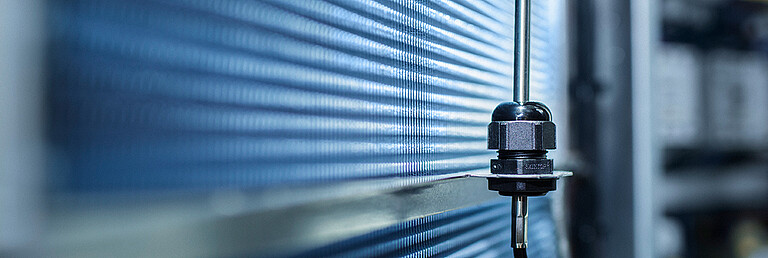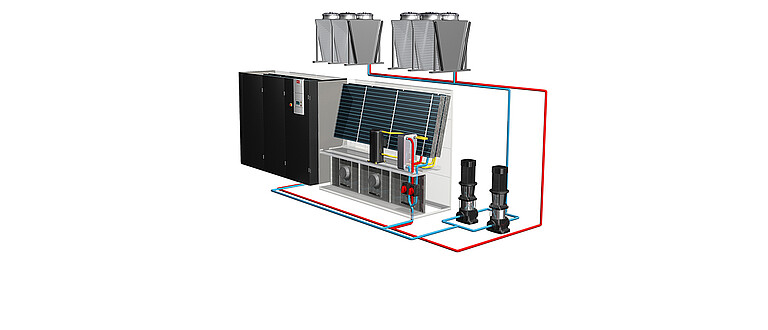Surely not many companies haven't asked themselves at least once what influence increasing digitization and Industry 4.0 will have on their business model. STULZ specialized in data center air conditioning back in 1971, and as a company we have experienced many digital trends in the flesh. But if you get to grips with the latest reports talking about the digital transformation and Industry 4.0, you quickly realize that this time we are facing something bigger. And one thing I notice is that the arguments are sometimes rather drastic. My impression is this: If you don't begin digital conversion immediately, your company will be finished in a few years' time. Or you can secure your future, turn everything upside down and undergo digital transformation.
Well, I don't see it as drastic as all that, but all companies should take action. They should analyze their business models, and they really need to try and determine to what degree digital transformation is necessary. Overhasty steps and digital actionism can rapidly backfire and wipe out a lot of capital. Companies specializing in complex industrial goods know that personal consultation, for example, cannot be replaced 1:1 by online consultation. However, when carrying out an analysis many companies will realize that they already started along the road to digital transformation a long time ago (see next paragraph).
Another difficulty during analysis is that digitization, digital transformation, IoT, big data, cloud computing and Industry 4.0 are often all lumped together, so no one can figure out whether they are affected and what exactly is important for the company.
The fact is: every company is affected, whatever they call the process. Consumer behavior in relation to products, services, communication, etc. is changing due to powerful mobile devices, fast data networks and state-of-the-art data centers. In addition, all data are collected and every technical device is connected. This is what the digital future looks like – and it is as inevitable as the rising of the sun in the morning.
Some negative aspects are undoubtedly apparent, but there are numerous advantages and opportunities that consumers and companies can use to their benefit. Every entrepreneur should ask themselves this: Exactly where must I digitally expand my business, my production, etc. in order to still find buyers in future, focus production better, or sell my services? The localization of real-time data and their use in personalized customer apps, in particular, offer brick-and-mortar stores the means of making personalized offers that are dispatched directly, for example. Here, the right timing matters. And for this you need to know exactly when a customer is ready to buy or – better still – when he has to buy, because the refrigerator is empty or his shoes are worn out.
Have the digital transformation and Industry 4.0 changed cooling solutions for data centers?
The digital transformation is without doubt one of the primary drivers of change in air conditioning systems for data centers, but further important reasons also exist: rising energy prices, changing regulations, new environmental requirements, higher safety standards, the allowance of more heat and humidity in data centers, and geographical considerations are some additional factors.
However, it is impossible to deny that new data center trends have arisen due to digital changes, especially in recent years. Digitization generates more data, which has led to the construction of many new, larger data centers. Moreover, existing data centers are regularly being equipped with new, more powerful servers.
But modernization in the form of new servers confronts data center operators with problems. Servers can easily be replaced with more powerful devices. This inevitably leads to a higher heat load over the existing surface area. The air conditioning units can generally be modernized, but it is not that simple to increase the number of chillers for removing the higher heat load. If a data center was planned for a heat load of 1 MW 10 years ago, and now 3 MW and more is being produced in the same space, the entire infrastructure – pipes, pumps, raised floors – has to be renovated. Additionally, more space is required in the data center for more air conditioning units, and further space for chillers is also needed outside the building.
Modernization with chillers and air handling units
In my opinion, data center operators have various means at their disposal for converting an existing structure. When renovating an existing CW system, chillers must be used that are specially designed for data center air conditioning, and feature maximum availability and Free Cooling, for example. This minimizes the energy disadvantages of conventional chillers. A standard chiller from the building's air conditioning system is out of place here, because it does not satisfy the project-specific requirements of a data center.
It is precisely for this reason that we developed our CyberCool 2. With the CyberCool 2, we offer a chiller with maximized heat exchanger surface areas and maximum size fans, which exploit the available space down to the last millimeter to improve air conduction. With the addition of effective Free Cooling and newly designed air conduction, the cooling capacity over an existing area is increased. Combined with maximum size CW indoor units, existing space can be put to better use, and then nothing stands in the way of expansion and more powerful servers.




